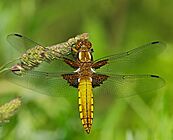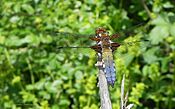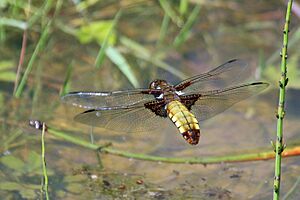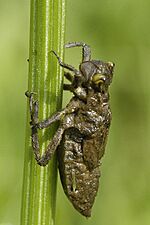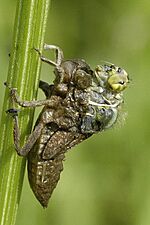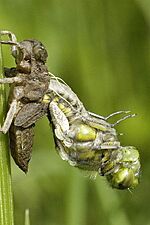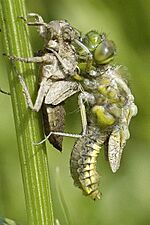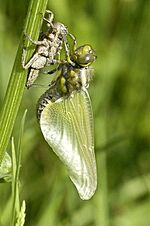Broad-bodied chaser facts for kids
Quick facts for kids Broad-bodied chaser |
|
|---|---|
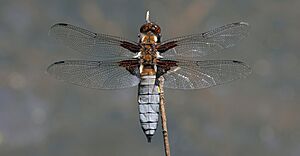 |
|
| male Wolvercote Lakes, Oxfordshire |
|
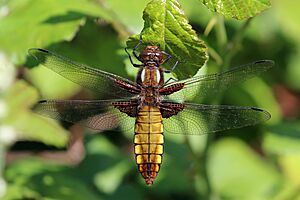 |
|
| female Otmoor, Oxfordshire |
|
| Scientific classification |
The broad-bodied chaser (Libellula depressa) is a common and easy-to-spot dragonfly found across Europe and central Asia. It's known for its very wide, flat body and four dark patches on its wings. Male broad-bodied chasers turn a cool powdery blue color as they get older.
Contents
How to Spot a Broad-Bodied Chaser
This dragonfly is about 39 to 48 millimeters (about 1.5 to 1.9 inches) long. Both males and females have a wide, flat body. This body is brown with bright yellow patches along the sides.
Color Changes in Males
As male broad-bodied chasers grow up, their brown body gets covered in a powdery blue coating. This blue color is called pruinosity. It makes them look very different from the females.
Distinctive Wings
Both the front and back wings of this dragonfly have a dark spot right at their base. Their average wingspan is about 70 millimeters (around 2.7 inches). These features make the broad-bodied chaser quite unique. You probably won't confuse it with other dragonflies in the same area.
Where They Live
Broad-bodied chasers live in central and southern Europe, central Asia, and the Middle East. You can find them as far north as England, southern Sweden, and southern Finland. They also live on some islands in the Mediterranean Sea, like Corsica and Sicily. While they weren't usually found in Scotland, some populations are now starting to appear there. However, you won't find them in Ireland or North Africa.
Favorite Hangouts
These dragonflies love places with still water, like lakes and ponds. They often feed on small insects flying around. You can see them in sunny spots with no plants, or in ponds with lots of plants. They are often the first dragonflies to move into new ponds that have just been created.
Away from Water
Adult broad-bodied chasers are very good at flying long distances. After they first hatch, they spend some time away from the water to grow and mature. They can also travel far, so you might see them flying in areas without any ponds nearby.
Life and Habits
You'll mostly see broad-bodied chasers flying from April to September, especially in May and June. They fly very fast, darting and diving over the water.
Territorial Behavior
Male broad-bodied chasers are very protective of their space. They will fight with other males and even other types of dragonflies that enter their territory. They often return to a favorite sunny spot to rest.
Mating and Eggs
When a female flies into a male's territory, the male will quickly fly up and grab her. They mate while flying, but only for a very short time, usually less than a minute. After mating, they separate. The female then looks for a good place to lay her eggs. This is usually an open area of water with plants growing underwater. She lays her eggs while flying, dipping the tip of her body into the water.
From Egg to Adult
The eggs hatch in about four to five weeks. The young dragonflies, called larvae, take one to two years to grow. They live in the mud and bits of plants at the bottom of the pond. They often bury themselves in the mud, with only their head and eyes showing. After they become adults, they fly away from the water for about 10 to 14 days to fully mature.
See also
- Libellula
- Libellulidae
- List of British dragonflies


